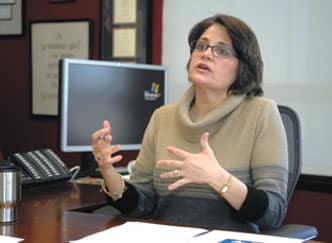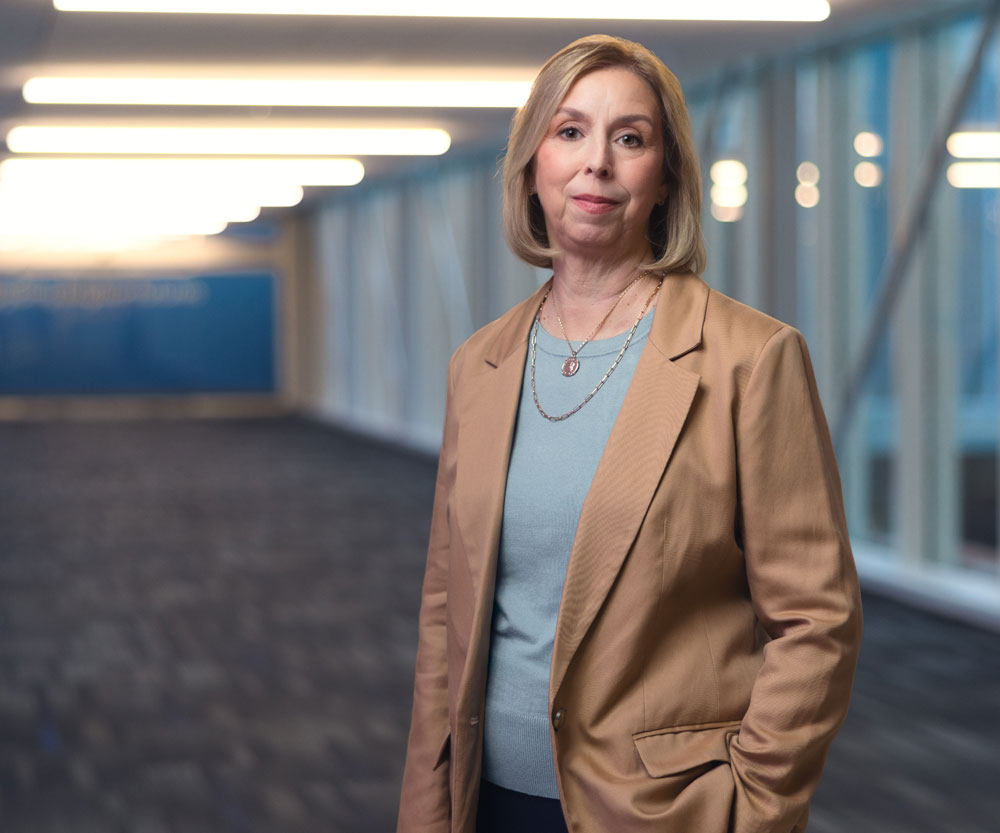Tomorrow’s Workers
Six local college presidents, including AIB’s Nancy Williams, talk about what their colleges are doing to prep students for your workforce.

.floatimg-left-hort { float:left; } .floatimg-left-caption-hort { float:left; margin-bottom:10px; width:300px; margin-right:10px; clear:left;} .floatimg-left-vert { float:left; margin-top:10px; margin-right:15px; width:200px;} .floatimg-left-caption-vert { float:left; margin-right:10px; margin-bottom:10px; font-size: 12px; width:200px;} .floatimg-right-hort { float:right; margin-top:10px; margin-left:10px; margin-bottom:10px; width: 300px;} .floatimg-right-caption-hort { float:left; margin-right:10px; margin-bottom:10px; width: 300px; font-size: 12px; } .floatimg-right-vert { float:right; margin-top:10px; margin-left:10px; margin-bottom:10px; width: 200px;} .floatimg-right-caption-vert { float:left; margin-right:10px; margin-bottom:10px; width: 200px; font-size: 12px; } .floatimgright-sidebar { float:right; margin-top:10px; margin-left:10px; margin-bottom:10px; width: 200px; border-top-style: double; border-top-color: black; border-bottom-style: double; border-bottom-color: black;} .floatimgright-sidebar p { line-height: 115%; text-indent: 10px; } .floatimgright-sidebar h4 { font-variant:small-caps; } .pullquote { float:right; margin-top:10px; margin-left:10px; margin-bottom:10px; width: 150px; background: url(http://www.dmbusinessdaily.com/DAILY/editorial/extras/closequote.gif) no-repeat bottom right !important ; line-height: 150%; font-size: 125%; border-top: 1px solid; border-bottom: 1px solid;} .floatvidleft { float:left; margin-bottom:10px; width:325px; margin-right:10px; clear:left;} .floatvidright { float:right; margin-bottom:10px; width:325px; margin-right:10px; clear:left;}
Even in this age of technology, many businesses are concerned that college students are graduating with some old-fashioned skills they’ll need to succeed in their careers.
Things like verbal communication, in-person presentations and the ability to think critically are skills that many Des Moines area collegs are trying to re-emphasize with their students.
That can become tricky when on one hand, mastering technology is necessary in education and in the business world, but on the other hand, relying on computers and text messaging can affect and even fundamentally change a person’s communication and reasoning skills.
“One of the things employers are telling us is they want students with good communication skills, and so that’s something that we’ve really been focusing on,” said Nancy Williams, president of AIB College of Business. “They have to be able to write a business letter still. It can’t just be all ‘LOL’ and lingo. We really talk about that, and it goes along with talk about basic skills of professional dress, how to be successful in business, you have to present well and learn how to network and talk to people.”
At the same time, businesses “want grads who have good knowledge of how to use a computer,” she said.
Williams believes AIB is striking a good balance on how to effectively teach both. How to teach both the use of technology and what are often referred to as “soft” skills are on the minds of many university officials.
The Business Record caught up with officials from six area colleges and universities to find out, essentially, “what’s new?”
Drake University
• Fall enrollment: 5,270 (down 2 percent from 2011)
• Website: www.drake.edu
• What’s new: The “Drake Curriculum”
Six or seven years ago, said Drake President David Maxwell, the university launched a campus-wide discussion with faculty, staff and students to come up with a consensus of what a Drake student looks like. The university turned it into a 4-page “foundational document” that answers the questions of “what are the habits of mind, skills and abilities that students need?” They came up things such as verbal and written communication skills, analytical skills and critical judgement, which have become part of what Maxwell calls the “Drake Curriculum.” A similar planning process is in the works again, of which the results will be released early this year.
• Business Demand: New majors, more globalization
Drake two years ago started an entrepreneurship major in recognition of how much the economy is being driven by small businesses, especially in the technology field. That program was endowed by Bill and Jean Buchanan. Other areas that have seen strong demand are actuarial science and pharmacy, as well as a health sciences major that was started four years ago. Maxwell also believes in the power of international experiences in the business world and in life, so the college added a J-term in January, in which students can spend three weeks abroad during the break between semesters.
• Biggest challenge: Students are wired differently
Students entering higher education today have spent much of their lives communicating through computers. Maxwell points to studies that show that people’s brains are literally wired differently in the upcoming generation of students. As such, current teaching models must adjust. Their brains are trained to think of many things on a superficial level as opposed to one thing on a deep and thoughtful level. “So how do you create learning environments that engage people who think that way when they get here, and then gradually rewire them to do the higher order of things of thoughtfulness and reflection?” Maxwell said. Also a challenge faced by the school, and not unique to Drake: the current financial model of higher education, which is causing students to graduate with debt.
Grandview University
• Fall enrollment: 2,232 (up less than 1 percent from 2011)
• Website: www.grandview.edu
• What’s new: Growth
Grand View has seen an explosion in enrollment growth in the past decade or more. The university has grown from 907 students in 2000 to 2,232 this year. A large part of that has come from growing the school’s athletic programs. Grand View launched its football program in 2008, and now has 24 sports teams after only having seven in 2000. Grand View is also preparing to launch a new core curriculum this fall, and will also restructure the organization of the university into two colleges: social and natural sciences, and arts and humanities.
• Business feedback: “Soft” skills
The basis of the university’s new curriculum, said Carol Bamford, vice president of marketing, is on the “soft” skills – communication ability, analytical and quantitative skills, problem solving and critical thinking. Also a large part of the curriculum will be initiatives related to helping students find their “calling” or “purpose” in life. “Employers tell us that a graduate’s passion for all of life is important,” Bamford said. “They want graduates who have been exposed to breadth and depth of thinking, creativity and global awareness, not just the nuts and bolts of a discipline.”
• Biggest challenge: Finding space
With growth comes space issues, Bamford said. “It continues to challenge us in terms of residential space, classroom space and staffing,” she said. Grand View in recent years has opened 180-person and 235-person residence halls, and has another residence facility under construction currently. The university this spring will also construct a pedestrian mall and plaza on Grandview Avenue between East 14th and East 13th Streets, and will begin renovating science labs and other facilities, Bamford said.
AIB College of Business
• Fall enrollment: 921 (up 6.5 percent from 2011)
• Website: www.aib.edu
• What’s new: Online education classes
Online education has become a large focus at AIB in recent years, particularly for working adult students, said President Nancy Williams. Though online learning might have a negative connotation, she says, AIB has strict standards to make online courses every bit as valuable as being in the classroom. “(Students) still have the exact same education taking their classes that way,” Williams said. “It just makes it more convenient for people that are working.” Many classes are what Williams refers to as “blended”: Instead of meeting for four hours or so on a given night, students meet for less time and do more of the work online, to save them from having to stay on campus until 9:30 p.m. Elements of online courses are largely the same as other course offerings. They fit into the college’s 11-week quarter system. They still require assignments to be completed, students get together for group projects and chat online or over the phone with their teachers, Williams said.
• What employers want: Keeping up with technology trends
Businesses have been looking for students to have more knowledge of how to use and promote their business on social media, and easily find information online. That has led to an increased cross-curriculum focus on those skills as well as a new contemporary business communications major to begin in fall of 2013. AIB last summer also started a corporate partner program to give tuition discounts to employees of partnering companies.
• Biggest challenge: Marketing the college as a private four-year institution
Many people still think of AIB as a two-year college, Williams said, but “we’re not the old AIB anymore.” Also playing into that challenge is fighting any perception that AIB is a for-profit institution. That has become more of a challenge in part because of the online curriculum, Williams said. “Sometimes I think online gets a bad rap because it gets tied to some of the for-profit colleges, but the online itself really is a teaching tool, a delivery tool.”
DMACC Des Moines Area Community College
• Fall enrollment: 23,685 (down 6.8 percent from 2011)
• Website: www.dmacc.edu
• What’s new: New degree programs
DMACC has added a number of new programs in recent years in response to business demand, including optometric technology, health information technology, paramedic specialists, pharmacy technician, wind turbine technologies and biomass maintenance.
• Employer Demand: Skilled workers
A recurring theme: “Not enough skilled workers for jobs that are currently open, or that are likely to come open,” said DMACC President Rob Denson said. DMACC works closely with the Iowa Association of Business and Industry, the Iowa Business Council and others, and Denson said he’s never seen a better team at the table to address the issue. DMACC has seen a large increase in demand for welders, even through the recession, in addition to machinists, healthcare professionals, criminal justice professionals and information technology workers. DMACC is also working to reach out to more minority students, Denson said, citing the college’s work with the Latino community in Perry.
• Biggest challenge: Money to add capacity
“We need physical space in order to offer more programs,” Denson said. “We’ve got waiting lists for nearly every one of our vocational programs.” For example, Denson says the school is running welding labs nearly 24 hours a day because there’s not enough space to teach during other hours. And he suspects students are either going to other colleges or choosing less in-demand majors when they can’t get into the program they want right away. The addition of 64,000 square feet at Southridge Mall will help. DMACC will use the space as a Career Academy and Learning Center, which will offer high-level vocational training for high school students and house the college’s Success Center, which offers GED and English language learning programs.
Simpson College
• Fall enrollment: 1,897 (up 1.6 percent from 2011)
• Website: www.simpson.edu
• What’s new: Change in leadership
Simpson recently hired Jay Simmons as the college’s 23rd president. Simmons, who has been president of Iowa Wesleyan College in Mount Pleasant for the past four years, will replace John Byrd, who is retiring at the end of May. “He’s going to want to reach out to the business community in the same way we’ve been doing for the last several years,” Byrd said of Simmons. “He’ll continue the process of finding ways to partner with the business community in terms of the type of graduates that we’re churning out.”
• Employer Demand: Student traits
Simpson recently completed a strategic planning process where it asked about 1,000 people, alumni and business leaders in Greater Des Moines: What do students out of college need to enter the workforce and be engaged citizens? People called for “things like the ability to work collaboratively, critical thinking skills, the ability to process information, the ability to public speak, quantitative reasoning, written communication,” said Steve Griffith, vice president and academic dean for the college. Simpson has made a point to infuse those things into its core curriculum. For example, rather than requiring students to take an oral communication class, more classes in a student’s major and core curriculum will require speeches and presentations.
• Biggest challenge: The economy
With Iowa student debt among the highest in the nation, uncertain economic conditions are not what the doctor ordered for higher education. Students and parents must deal with paying for higher education with shrinking budgets, and in some cases just not knowing what the future holds financially. “I think we’re probably not alone in that regard,” Griffith said.
Des Moines University
• Fall enrollment: 1,801 (down less than 1 percent from 2011)
• Website: www.dmu.edu
• What’s new: New president, new focus
Angela Franklin took over as president of Des Moines University less than two years ago, and since then the university has laid out four distinct vision statements of its roles: being a leader in health education, cultivating researchers, being a leader of health services in the community and being a catalyst to make Des Moines a more healthy community.
• Business Demand: Partnering with others
Franklin wants to figure out where to take the university’s clinic, and she’s looking for feedback from other health organizations in the city. DMU has already partnered with Mercy, Iowa Health, Broadlawns Medical Center and the Veterans Affairs Central Iowa Health Care System. “We’re all working together in what we’re calling a Des Moines University clinical collaborative, focusing on finding better ways to interface to benefit the training of our students,” Franklin said. “It’s pretty clear that healthcare is changing so drastically that we can’t afford to be on an island by ourselves.” Another way that DMU has plugged itself into the community was by moving the Hispanic clinic, La Clinica de la Esperanza, to the DMU campus. La Clinica is owned by Iowa Health but rents out DMU space.
• Biggest challenge: More student opportunities
“How do we get more opportunities for students to train in environments where we’d like to keep them for practice?” Franklin asks. She would like to see more opportunities for students to stay in Iowa for post-graduate residency training. She hopes that by partnering with other health providers in the area on the university clinic, students will have with more opportunities.








